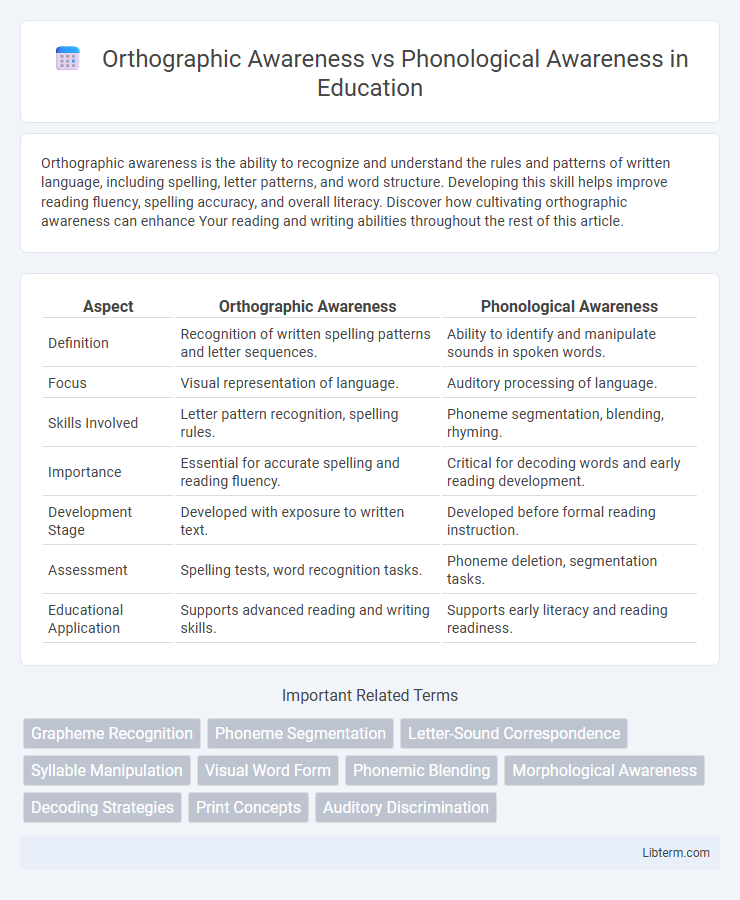Orthographic awareness is the ability to recognize and understand the rules and patterns of written language, including spelling, letter patterns, and word structure. Developing this skill helps improve reading fluency, spelling accuracy, and overall literacy. Discover how cultivating orthographic awareness can enhance Your reading and writing abilities throughout the rest of this article.
Table of Comparison
| Aspect | Orthographic Awareness | Phonological Awareness |
|---|---|---|
| Definition | Recognition of written spelling patterns and letter sequences. | Ability to identify and manipulate sounds in spoken words. |
| Focus | Visual representation of language. | Auditory processing of language. |
| Skills Involved | Letter pattern recognition, spelling rules. | Phoneme segmentation, blending, rhyming. |
| Importance | Essential for accurate spelling and reading fluency. | Critical for decoding words and early reading development. |
| Development Stage | Developed with exposure to written text. | Developed before formal reading instruction. |
| Assessment | Spelling tests, word recognition tasks. | Phoneme deletion, segmentation tasks. |
| Educational Application | Supports advanced reading and writing skills. | Supports early literacy and reading readiness. |
Introduction to Orthographic and Phonological Awareness
Orthographic awareness involves recognizing the visual patterns and structures of written language, such as letter sequences and spelling conventions, which are essential for fluent reading and writing. Phonological awareness refers to the ability to identify and manipulate the sound units of language, including phonemes, syllables, and rhymes, forming the foundation for decoding words. Both orthographic and phonological awareness are critical components of early literacy development, enabling learners to connect spoken language with its written form.
Defining Orthographic Awareness
Orthographic awareness refers to the ability to recognize written letter patterns and spelling conventions within a language, enabling efficient decoding and word recognition. It involves understanding the visual representation of words, including knowledge of letter positions, patterns, and morphological structures. This skill is distinct from phonological awareness, which focuses on the auditory aspects of language such as sounds and syllables.
Understanding Phonological Awareness
Phonological awareness refers to the ability to recognize and manipulate sounds in spoken language, including syllables, onsets, rimes, and phonemes. This skill is crucial for decoding words during reading and serves as a foundational component for literacy development. Unlike orthographic awareness, which focuses on understanding written letter patterns and spelling conventions, phonological awareness emphasizes auditory processing and sound segmentation.
Key Differences Between Orthographic and Phonological Awareness
Orthographic awareness involves recognizing written letter patterns, spelling conventions, and the visual representation of language, while phonological awareness focuses on identifying and manipulating individual sounds or phonemes in spoken words. Orthographic skills are essential for reading fluency and spelling accuracy, whereas phonological awareness is critical for decoding sounds and early reading development. The key difference lies in orthographic awareness emphasizing visual-symbolic knowledge and phonological awareness concentrating on auditory-linguistic processing.
The Role of Orthographic Awareness in Reading Development
Orthographic awareness, the recognition of letter patterns and visual word forms, plays a crucial role in reading development by enabling efficient word recognition and spelling. Unlike phonological awareness, which focuses on sound structures, orthographic awareness supports fast decoding and fluent reading through familiarity with common letter sequences and word shapes. Developing orthographic skills enhances reading accuracy and speed, facilitating comprehension and literacy growth in young learners.
The Role of Phonological Awareness in Early Literacy
Phonological awareness plays a critical role in early literacy by enabling children to recognize and manipulate sounds within spoken words, which is essential for developing decoding skills. Unlike orthographic awareness, which focuses on the visual patterns and letter arrangements in writing, phonological awareness targets the auditory and oral aspects of language processing. Mastery of phonological awareness strongly predicts successful reading acquisition and supports the transition to proficient word recognition and spelling.
Interplay Between Orthographic and Phonological Systems
Orthographic awareness involves recognizing letter patterns and spelling conventions, while phonological awareness centers on identifying and manipulating speech sounds. The interplay between these systems is crucial for proficient reading and writing, as integrated processing of orthographic and phonological information facilitates accurate decoding and word recognition. Research highlights that strong connections between orthographic and phonological representations support literacy development and enhance reading fluency.
Common Challenges in Developing Each Awareness
Orthographic awareness involves recognizing letter patterns and spelling rules, while phonological awareness focuses on identifying and manipulating sounds in spoken language. Common challenges in developing orthographic awareness include difficulty memorizing irregular spelling patterns and differentiating visually similar letters. Phonological awareness difficulties often arise from struggles with segmenting sounds, blending phonemes, and identifying rhymes, impacting early reading and decoding skills.
Instructional Strategies for Enhancing Awareness Skills
Effective instructional strategies for enhancing orthographic awareness include explicit teaching of letter patterns, morphemes, and visual word recognition through multisensory activities and structured spelling instruction. Phonological awareness improves with systematic practice in segmenting, blending, and manipulating sounds using rhymes, phoneme isolation, and auditory discrimination games. Integrating both approaches within balanced literacy programs supports decoding skills, fluent reading, and spelling proficiency.
Conclusion: Integrating Orthographic and Phonological Awareness for Literacy Success
Integrating orthographic awareness, which involves recognizing letter patterns and spelling conventions, with phonological awareness, the ability to identify and manipulate sounds in spoken language, is crucial for literacy success. This combined approach enhances reading fluency and spelling accuracy by allowing learners to connect sounds with their corresponding letters and patterns effectively. Targeted instruction that simultaneously develops both skills supports comprehensive literacy development and better reading outcomes.
Orthographic Awareness Infographic

 libterm.com
libterm.com